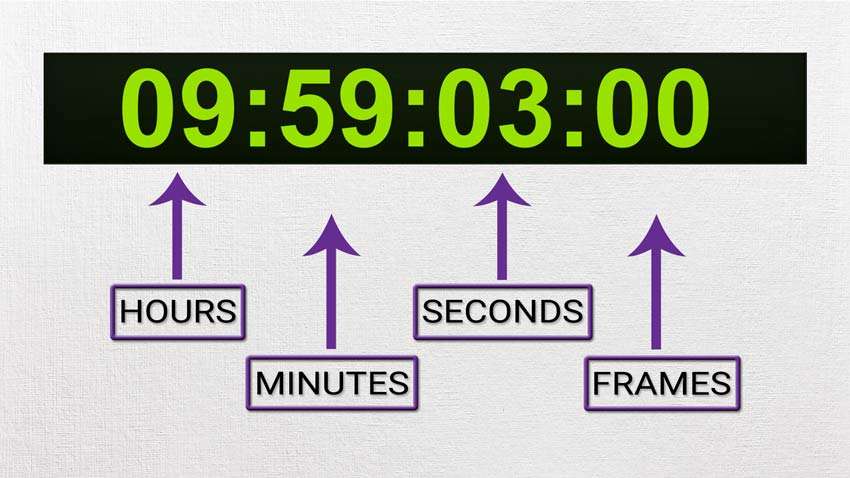
What is Time Code
A time code is a series of numbers generated in a controlled sequence by a timing system. In a video and other recorded media a time code can be added to a recording in order to facilitate logging, synchronization, file and searching, etc.
- The camera assistant will typically log the start and end time codes of shorts, and the data generated will be sent on to the editorial department for use in referencing those shots.
- Time-codes, then, are numbers assigned to the frames – one per frame, to be precise. They are written as a variation of hours: minutes: seconds; frames, so that a user can tell immediately which frame in a video each time-code refers to.
- For example, the time-code 00:13:30:15 refers to:
- 00 hours, 13minutes, 30seconds, 15 frames
- Digital video is composed of frames that flash, very quickly, one after the other. If you’ve hit frame fast forward on your DVD player, you’ve seen that each time you do so, the image lands on the picture- essentially it’s landing on a single frame. When the video plays at a normal speed usually twenty-four or twenty-nine frames- per second, or flips your eye doesn’t see each individual frame, but rather it registers the succession as motion.
- This short – logging process was traditionally done by hand using pen and paper but is now typically done using short logging software running on a laptop computer that is connected to the time code generator or the camera itself. A professional video camera has the ability to generate ‘’time code’’.
Do Time codes matter? (Yes)
- Time-codes are a fundamental part of how we work with video content, and it’s necessary to have a basic knowledge of them for subtitling, Video translation or video editing. This is because time-coding issues are the primary cause of cost and timeline overruns in subtitles localization projects.
What is A Window Dub?
Most of the time raw video is shot in a professional format that clients cannot easily manipulate. Either it’s CODED that their computer has a problem running or it’s in a proprietary video format such as p two. However, there is one option we can provide to help clients view the video footage we just shot; we can provide you with windows dub.
Time code is an invisible digital address that is recorded along with the audio and video. When processing the video, a production company has the ability to superimpose the time code onto the multimedia making it visible. This is what’s known as ‘’window dub’’
How Is Time Code Significant For Subtitlers?
- For one to do subtitling work has to undergo special training on how to keenly key in the time in and time out in a video as s/he watches the video. While doing the work, the subtitler has to be very attentive to capture every start frame and adjust appropriately failure to which can miss the flow of the video which will prompt him/her start again.
- In video editing and production, time-codes are a kind of lingua franca. They’re especially useful because each one is unique and exact, as we just noted. Therefore, anything related to the video is expressed in these numbers – this includes subtitles code.
- Each subtitle is synchronized to its corresponding audio – so for example, if you have a subtitle for someone saying “Hello! How are you?,” you’ll want it to appear when he or she starts speaking this line, and then disappear once he or she is done speaking the line. More specifically, you’ll want the subtitle to appear in the same frame when the audio begins, and disappear in the same frame when the audio ends. The only way to communicate this to a subtitling system is by giving in a “start” and “end” time-code for each subtitle, as in the following SRT subtitles file:
- In the SRT subtitle code, you see the start time-code, then a separator (–> in this case), then the end time-code, then another separator (a line break, in this case), and finally, the text to be displayed. In this example, the first subtitle will start displaying in frame 00:00:12; 01 (first frame after 12 seconds), and then disappear at 00:00:15; 18 (18th frame after 15 seconds).SRT is just one of the many subtitles formats, and they all follow a similar pattern, displaying the start and end time-codes, followed by the text to be displayed. Some formats don’t assign a number to each subtitle (in the SRT above, you can see 1, 2 and 3). Likewise, some formats don’t display end time-codes, so that the subtitles stay on-screen until they’re replaced by the next one.
Using Time Code For Successful Subtitles Projects
There are two things you must know about time-codes to make sure that subtitles projects go smoothly:
- Time-codes are exact, and they’re codes, just like a programming language (think of HTML) – therefore, one changed/deleted character in them will render them useless, just like deleting a single “<” in HMTL code may wreck a page. A subtitles system won’t know what to do with the time-code 02:12:0; 23 for example, because the frame number doesn’t have two digits in the section for seconds (in red). For this reason, it’s crucial to make sure that time-codes do not get altered during translation – one single change can mean an extra hour of work during subtitles integration, as well as a very frustrated editor.
- Time-codes can be re-set during editing. This last statement can seem contradictory since we just said that time-codes are exact. However, an editor can re-set the actual number assigned to a frame, usually by re-setting the first frame. For example, if an editor adds a frame of video to the beginning, that frame will become the “zero” frame – 00:00:00; 00. That means that the following frame – previously the zero frames – will become 00:00:00:01. And so on, until the video ends. This process is crucial to understand because it happens all the time. For example, after a video is completed, an editor may add 20 black frames at the beginning, just because a site that wants the video requires it (usually for a logo transition). If so, this means that there are two versions of the video out in the world, and they’re not frame-accurate – that means that the zero frame (00:00:00; 00) in one video doesn’t correspond to the zero frame in the other. This is why it’s so necessary to make sure working copies of a video for subtitling are frame-accurate to the final, high-resolution version of the video – it’s also why we ask this question a lot in subtitles projects.
Why is Timecode significant when editing a video?
- Time code allows video producers to take meaningful notes. When taking the notes skip the frames, since they are 1/30ths, or 1/4ths, of a second- way too fast to be accurate at this point. Since time code is digital address the numbers are ‘’fixed’’ to the footage. It’s not arbitrary, it’s an exact time.
- If you plug this number into an editing timeline, the program will take you to this exact spot – in a single video, there can be no other spot with this time-code, since frames are the smallest single units of video. This gets to one of the core attributes of time-codes – within a video; each one is unique to a single frame. Two frames in a video can’t have the same time-code, and a single time-code can’t refer to two frames in a video.
- By viewing window dubs, producers and clients can determine what parts of interviews they like choose amongst several takes of the same comments and get a feel for what the footage looks like. Whether done in a spreadsheet or even just a pencil and paper, it’s an efficient way to know and prepare for how the footage will be edited.
- Additionally, by logging the footage in advance of the edit, clients can get their project produced faster. This will help to hold down costs when producing corporate and broadcast video productions.
Ultimately, the key to time-codes is to understand just how exact they need to be – on the one hand, this specificity allows for a subtitling workflow that is precise and reproducible, and that produces subtitles for multiple formats. If final videos are frame-accurate to the working copies, and translators don’t alter the time-codes in any way, subtitles projects go smoothly. However, if there are any issues with the time-codes during production, small as they maybe they will almost certainly delay project timelines and add to the cost.







